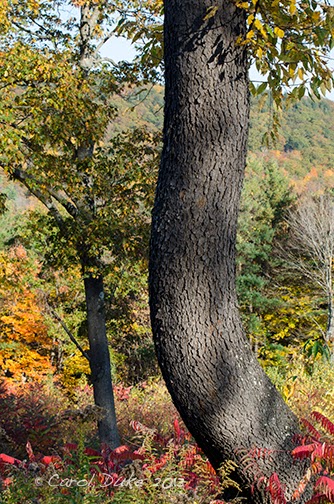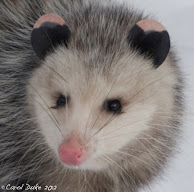In thinking along the stream of thought inspired by Wendall Berry, I have been pondering 'my place' within my place and the community I am blessed to have membership in. I am speaking of the land, of the trees and shrubberies, of the species of butterflies and bees and birds that coexist here at Flower Hill Farm. There is a language I have come to understand and the understanding came as soon as I let go of the ideas of gardening I held true and when I stopped and listened to the needs of the life all around me.
A Shagbark Hickory out in the upper garden and a Rock Maple (Sugar Maple) on the south side of the old farmhouse are both wearing cloaks of Climbing Hydrangea. The Rock Maple's yellow fleece will be getting a good trim once the leaves have all fallen, for I do not wish to cover the maple's beautiful bark.
Copious carpets of leaves linger until a blustery wind whips them around the gardens. Like a down comforter the leaves softly lay upon the ground sheltering many sleeping insects.
The community I belong to here is so wildly wondrous and giving.
Our favorite Black Cherry had a rough beginning but with determination it grew over and above the conditions trying to hold it back.
Ever reaching towards cloud and sky, the native cherry also survived losing half of its canopy two years ago. I believe all the neighboring members of the community felt the shock and I was deeply concerned for its survival.
In the photograph above, taken in October of 2009, the Black Cherry was still sporting its full canopy of flaxen tresses. There is danger in a V when worn by a tree. Just at the V. . . the entire branching going off to the right split off and was hanging threatening a deadly tear. It was skillfully cut off before that could happen.
Besides it unique form this Black Cherry also holds a dear friend's ashes within its roots and crusty body. We call it 'Michael's tree'. He was a man who loved trees and is forever a beloved member of this community.
The Black Cherry seems to be thriving and continues to be the preferred canopy of the Baltimore Orioles each spring and summer.
It has been one of the most beautiful and long lasting falls I can recall. It was as if every tree sang out . . . a choir of vibrant leafy voices carried by a breath of wind throughout the landscape. The river and rivulets below join in plashing their melodious meanderings about the wood. It was a joy to experience it all.
During my walk I also caught sight of a perfect Mourning Cloak . . . who by now has crawled within a crack or crevice of bark or under a rock or fallen branch in its full butterfly form and hopefully will safely sleep throughout the winter months. I will not move any fallen wood at this time nor disturb any assemblages of detritus for they may be home to tiny, delicate members of this diverse commune of life.
Many members feed other members of our community. It is hard at times to love all the species equally and be detached. We have enjoyed a few Yellow-rumped Warblers as they dart about gleaning dried seed heads of goldenrod and other plants scattered within the fields and gardens. They are busy in the trees too harvesting tiny larva and other meaty members. I do not recall seeing these curious warblers in the gardens this late before.
The Yellow-rumped Warblers have now cast off their brighter breeding costumes or perhaps this is a juvenile.
Come spring again the warblers will be wearing their dark masks and their return will surely be a treat.






































































































































